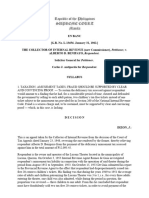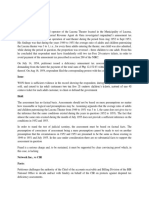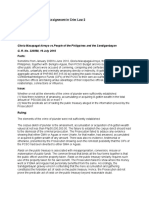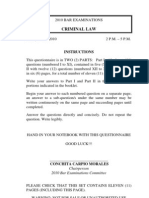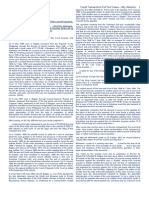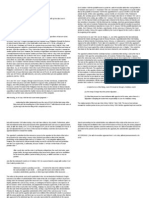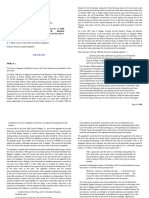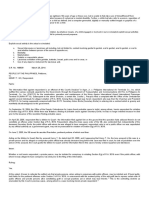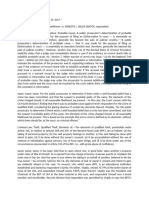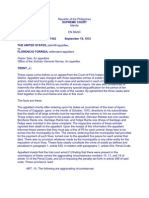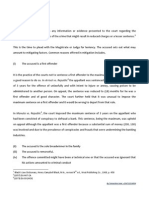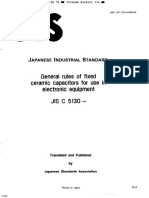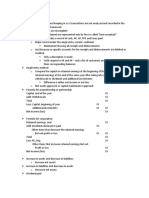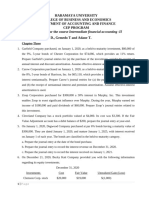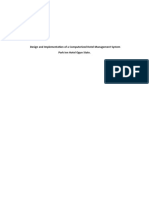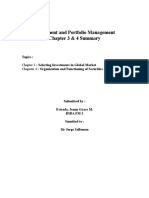0 ratings0% found this document useful (0 votes)
191 viewsCollector Vs Benipayo
Collector Vs Benipayo
Uploaded by
Arnold JoseThe respondent owned a movie theater in Lucena, Quezon. An internal revenue agent investigated the respondent's amusement tax liability from 1952 to 1953. Based on attendance ratios from 1949 to 1951, the agent concluded without evidence that the respondent fraudulently sold two tax-free children's tickets instead of one adult ticket, avoiding tax payment. The petitioner issued a tax assessment of over P12,000 based on this presumption. However, the court found the assessment had no factual basis and presumptions could not be made without evidence. Fraud also requires clear proof which was lacking. The assessment was annulled.
Copyright:
© All Rights Reserved
Available Formats
Download as DOCX, PDF, TXT or read online from Scribd
Collector Vs Benipayo
Collector Vs Benipayo
Uploaded by
Arnold Jose0 ratings0% found this document useful (0 votes)
191 views2 pagesThe respondent owned a movie theater in Lucena, Quezon. An internal revenue agent investigated the respondent's amusement tax liability from 1952 to 1953. Based on attendance ratios from 1949 to 1951, the agent concluded without evidence that the respondent fraudulently sold two tax-free children's tickets instead of one adult ticket, avoiding tax payment. The petitioner issued a tax assessment of over P12,000 based on this presumption. However, the court found the assessment had no factual basis and presumptions could not be made without evidence. Fraud also requires clear proof which was lacking. The assessment was annulled.
Original Title
Collector vs Benipayo.docx
Copyright
© © All Rights Reserved
Available Formats
DOCX, PDF, TXT or read online from Scribd
Share this document
Did you find this document useful?
Is this content inappropriate?
The respondent owned a movie theater in Lucena, Quezon. An internal revenue agent investigated the respondent's amusement tax liability from 1952 to 1953. Based on attendance ratios from 1949 to 1951, the agent concluded without evidence that the respondent fraudulently sold two tax-free children's tickets instead of one adult ticket, avoiding tax payment. The petitioner issued a tax assessment of over P12,000 based on this presumption. However, the court found the assessment had no factual basis and presumptions could not be made without evidence. Fraud also requires clear proof which was lacking. The assessment was annulled.
Copyright:
© All Rights Reserved
Available Formats
Download as DOCX, PDF, TXT or read online from Scribd
Download as docx, pdf, or txt
0 ratings0% found this document useful (0 votes)
191 views2 pagesCollector Vs Benipayo
Collector Vs Benipayo
Uploaded by
Arnold JoseThe respondent owned a movie theater in Lucena, Quezon. An internal revenue agent investigated the respondent's amusement tax liability from 1952 to 1953. Based on attendance ratios from 1949 to 1951, the agent concluded without evidence that the respondent fraudulently sold two tax-free children's tickets instead of one adult ticket, avoiding tax payment. The petitioner issued a tax assessment of over P12,000 based on this presumption. However, the court found the assessment had no factual basis and presumptions could not be made without evidence. Fraud also requires clear proof which was lacking. The assessment was annulled.
Copyright:
© All Rights Reserved
Available Formats
Download as DOCX, PDF, TXT or read online from Scribd
Download as docx, pdf, or txt
You are on page 1of 2
193. Collector vs.
Benipayo (4 SCRA 182)
Facts:
Respondent is the owner and operator of the Lucena Theater located in the municipality
of Lucena, Quezon. On October 3, 1953 Internal Revenue Agent Romeo de Guia
investigated respondent's amusement tax liability in connection with the operation of said
theater during the period from August, 1952 to September, 1953. His finding was that
during the years 1949 to 1951 the average ratio of adults and children patronizing the
Lucena Theater was 3 to 1, i.e., for every three adults entering the theater, one child was
also admitted, while during the period in question. the proportion was reversed—three
children to one adult. From this he concluded that respondent must have fraudulently sold
two tax-free 20-centavo tickets, in order to avoid payment of the amusement tax
prescribed in Section 260 of the National Internal Revenue Code.
On July 14, 1954. petitioner issued a deficiency amusement tax assessment against
respondent, demanding from the latter the payment of the total sum of P12,152.93 within
thirty days from receipt thereof. On August 16, 1954, respondent filed the corresponding
protest with the Conference Staff of the Bureau of Internal Revenue.
Issue:
Whether or not there is sufficient evidence in the record showing that respondent, during
the period under review, sold and issued to his adult customers two tax-free 20-centavo
children's tickets, instead of one 40-centavo ticket for each adult customer; to cheat or
defraud the Government.
Held:
The assessment has no factual bases. Assessments should not be based on mere
presumptions no matter how reasonable or logical said presumptions may be. Assuming
arguendo that the average ratio of adults and children patronizing the Lucena Theater
from 1949 to 1951 was 3 to 1, the same does not give rise to the inference that the same
conditions existed during the years in question (1952 and 1953). The fact that almost the
same ratio existed during the month of July, 1955 does not provide a sufficient inference
on the conditions in 1952 and 1953. x x x
"In order to stand the test of judicial scrutiny, the assessment must be based on actual
facts. The presumption of correctness of assessment being a mere presumption cannot be
made to rest on another presumption that the circumstances in 1952 and 1953 are
presumed to be the same as those existing in 1949 to 1951 and July 1955. In the case
under consideration there are no substantial facts to support the assessment in question. x
x x."
Fraud is a serious charge and, to be sustained, it must be supported by clear and
convincing proof which, in the present case, is 'lacking.
You might also like
- 6.18 CIR Vs BenipayoDocument4 pages6.18 CIR Vs BenipayoMeg VillaricaNo ratings yet
- CIR V BenipayoDocument4 pagesCIR V BenipayoJuris PasionNo ratings yet
- G.R. No. L-13656 January 31, 1962 COLLECTOR OF INTERNAL REVENUE, (Now Commissioner), Petitioner, ALBERTO D. BENIPAYO, RespondentDocument3 pagesG.R. No. L-13656 January 31, 1962 COLLECTOR OF INTERNAL REVENUE, (Now Commissioner), Petitioner, ALBERTO D. BENIPAYO, RespondentMarie Nickie BolosNo ratings yet
- G.R. No. L-13656Document3 pagesG.R. No. L-13656joachimjackNo ratings yet
- 215-CIR v. Benipayo G.R. No. L-13656 January 31, 1962Document3 pages215-CIR v. Benipayo G.R. No. L-13656 January 31, 1962Jopan SJNo ratings yet
- G.R. No. L-13656Document2 pagesG.R. No. L-13656Josef elvin CamposNo ratings yet
- CIR vs. BenipayoDocument5 pagesCIR vs. BenipayoHannah BarrantesNo ratings yet
- CIR v. BenipayoDocument1 pageCIR v. BenipayoAnonymous Xg8pRjytnNo ratings yet
- CIR Vs Benipayo G.R. L-13656Document1 pageCIR Vs Benipayo G.R. L-13656MACNo ratings yet
- Benipayo and Network Inc. CasesDocument3 pagesBenipayo and Network Inc. CasesSheilaNo ratings yet
- FalsificationDocument5 pagesFalsificationalexjalecoNo ratings yet
- (GR No. L-9572, Jul 31, 1956) Joaquin Guzman V. Ca: DecisionDocument5 pages(GR No. L-9572, Jul 31, 1956) Joaquin Guzman V. Ca: DecisionWild FlowerNo ratings yet
- Midterm Case DigestDocument5 pagesMidterm Case DigestMeghan JAPSONNo ratings yet
- Canon 12 PNB V Uy Teng Piao Nature FactsDocument2 pagesCanon 12 PNB V Uy Teng Piao Nature FactsMonaliza LiztsNo ratings yet
- CRIM2 DigestsDocument6 pagesCRIM2 DigestsblimjucoNo ratings yet
- Labor Law Cases Part 3Document47 pagesLabor Law Cases Part 3ArVinMendozaNo ratings yet
- (20-4) Guzman Vs CADocument4 pages(20-4) Guzman Vs CANika RojasNo ratings yet
- 2010 Bar Examination Question: 12 September 2010 InstructionsDocument6 pages2010 Bar Examination Question: 12 September 2010 InstructionsMatt ReginoNo ratings yet
- Pe Vs RepublicDocument2 pagesPe Vs RepublicGenison BasilioNo ratings yet
- D. T. Reyes, Liaison and Associates For Petitioner-Appellant. Office of The Solicitor General For Plaintiff-AppelleeDocument54 pagesD. T. Reyes, Liaison and Associates For Petitioner-Appellant. Office of The Solicitor General For Plaintiff-AppelleeStella BertilloNo ratings yet
- Criminal Law QuestionnaireDocument6 pagesCriminal Law QuestionnaireJoJabinesNo ratings yet
- Criminal Law: InstructionsDocument11 pagesCriminal Law: Instructionsben_23No ratings yet
- 15149110-1956-Guzman v. Court of Appeals20170102-672-13fe79sDocument4 pages15149110-1956-Guzman v. Court of Appeals20170102-672-13fe79sChristine Ang CaminadeNo ratings yet
- Credit Transactions LOANSDocument50 pagesCredit Transactions LOANSTrixie MarianoNo ratings yet
- 01 Republic v. BagtasDocument5 pages01 Republic v. BagtasClarinda MerleNo ratings yet
- Credit - LoanDocument98 pagesCredit - LoanKris BorlonganNo ratings yet
- Republic Vs BagtasDocument4 pagesRepublic Vs BagtasRaven DizonNo ratings yet
- Credit Trans CasesDocument24 pagesCredit Trans CasesCarren Paulet Villar CuyosNo ratings yet
- Forms of Escape From TaxationDocument6 pagesForms of Escape From TaxationKath LeenNo ratings yet
- Republic Vs BagtasDocument4 pagesRepublic Vs BagtasGorgeousENo ratings yet
- Assignment No 6.1Document64 pagesAssignment No 6.1rollanekimNo ratings yet
- Credit Transactions - Atty. Julian Rodrigo A. Dela CruzDocument3 pagesCredit Transactions - Atty. Julian Rodrigo A. Dela CruzAndrei Da JoseNo ratings yet
- Cases Commodatum To Deposit Chapter 1Document102 pagesCases Commodatum To Deposit Chapter 1Shine BillonesNo ratings yet
- Credit CasesDocument209 pagesCredit CasesBernadine NacuaNo ratings yet
- Perjury DecisionDocument5 pagesPerjury DecisionLzl Bastes100% (1)
- Siasat-Vs - IACDocument3 pagesSiasat-Vs - IACmayyhobelNo ratings yet
- RP vs. BalagtasDocument3 pagesRP vs. BalagtasAyra CadigalNo ratings yet
- D. T. Reyes, Liaison and Associates For Petitioner-Appellant. Office of The Solicitor General For Plaintiff-AppelleeDocument2 pagesD. T. Reyes, Liaison and Associates For Petitioner-Appellant. Office of The Solicitor General For Plaintiff-AppelleeBec Bec BecNo ratings yet
- C3. Republic v. Bagtas, 6 SCRA 262Document3 pagesC3. Republic v. Bagtas, 6 SCRA 262dondzNo ratings yet
- Yanong - Article 172 To 178Document13 pagesYanong - Article 172 To 178Maria Anny YanongNo ratings yet
- Last Batch CRIMDocument6 pagesLast Batch CRIMmichaelargabiosoNo ratings yet
- Credit Trans Cases CompleteDocument505 pagesCredit Trans Cases CompleteFaye Michelle LadanNo ratings yet
- G.R. No. L-12471 April 13, 1959 ROSARIO L. DE BRAGANZA, ET AL., PetitionersDocument66 pagesG.R. No. L-12471 April 13, 1959 ROSARIO L. DE BRAGANZA, ET AL., PetitionersPam NolascoNo ratings yet
- Palacio v. Fely Transportation Co., 5 SCRA 1011 (1962)Document9 pagesPalacio v. Fely Transportation Co., 5 SCRA 1011 (1962)inno KalNo ratings yet
- Torts DigestDocument18 pagesTorts DigestJeanniferL.FloresNo ratings yet
- Case DigestDocument3 pagesCase DigestMarc Justine BoralNo ratings yet
- Consti Cases SeptDocument14 pagesConsti Cases SeptMczoC.MczoNo ratings yet
- April 2Document3 pagesApril 2AngelNo ratings yet
- Plaintiff-Appellee vs. vs. Defendant Petitioner-Appellant D. T. Reyes, Luison & Associates Solicitor GeneralDocument4 pagesPlaintiff-Appellee vs. vs. Defendant Petitioner-Appellant D. T. Reyes, Luison & Associates Solicitor GeneralIvan LuzuriagaNo ratings yet
- People vs. Delos Santos - Qualified Theft 2017Document8 pagesPeople vs. Delos Santos - Qualified Theft 2017mlpespinaNo ratings yet
- D. T. Reyes, Liaison and Associates For Petitioner-Appellant - Office of The Solicitor General For Plaintiff-AppelleeDocument100 pagesD. T. Reyes, Liaison and Associates For Petitioner-Appellant - Office of The Solicitor General For Plaintiff-AppelleeRB BalanayNo ratings yet
- Plaintiff-Appellant Vs Vs Defendant-Appellee Assistant Solicitor General Florencio Villamor Solicitor Jorge C. Coquia Manuel O. SorianoDocument3 pagesPlaintiff-Appellant Vs Vs Defendant-Appellee Assistant Solicitor General Florencio Villamor Solicitor Jorge C. Coquia Manuel O. SorianoAmberChanNo ratings yet
- Aggravating CasesDocument114 pagesAggravating CasesRonn PetittNo ratings yet
- 1 MitigationDocument8 pages1 MitigationTumusiime IsaacNo ratings yet
- Republic Vs BagtasDocument3 pagesRepublic Vs BagtasMariel Grace DelinNo ratings yet
- 11 Republic v. Bagtas, G.R. No. L-17474, (October 25, 1962), 116 PHIL 570-576Document5 pages11 Republic v. Bagtas, G.R. No. L-17474, (October 25, 1962), 116 PHIL 570-576Vianice BaroroNo ratings yet
- Report of Al Capone for the Bureau of Internal RevenueFrom EverandReport of Al Capone for the Bureau of Internal RevenueNo ratings yet
- EEOC: The Real Deal - Do They Really Support Title VII of the 1964 Civil Rights Act?From EverandEEOC: The Real Deal - Do They Really Support Title VII of the 1964 Civil Rights Act?No ratings yet
- No Case to Answer: The Men who Got Away with the Great Train RobberyFrom EverandNo Case to Answer: The Men who Got Away with the Great Train RobberyNo ratings yet
- Crises of the Republic: Lying in Politics, Civil Disobedience, On Violence, Thoughts on Politics and RevolutionFrom EverandCrises of the Republic: Lying in Politics, Civil Disobedience, On Violence, Thoughts on Politics and RevolutionRating: 3.5 out of 5 stars3.5/5 (3)
- Draft Spa - Noor FaizanDocument22 pagesDraft Spa - Noor FaizannailahNo ratings yet
- ConclusionDocument29 pagesConclusionVarunMalhotra100% (1)
- AmazonDocument15 pagesAmazonManoj MohanthyNo ratings yet
- Nsa 230 Application Material UpdatedDocument12 pagesNsa 230 Application Material UpdatedbinuNo ratings yet
- Participants Manual 5Document79 pagesParticipants Manual 5alazarfeteneNo ratings yet
- Deed of Transfer of Rights With Assumption of Obligation Pag Ibig BlankDocument4 pagesDeed of Transfer of Rights With Assumption of Obligation Pag Ibig BlankSherwin HermanoNo ratings yet
- Introduction - PMP® Exam Prep Course - Jan 2023 ReleaseDocument14 pagesIntroduction - PMP® Exam Prep Course - Jan 2023 ReleaseKrsnaNo ratings yet
- Jis C5130Document50 pagesJis C5130Han Win Aung0% (1)
- Strategic Supply Chain Management PPT ScheduleDocument3 pagesStrategic Supply Chain Management PPT ScheduleMan unitedNo ratings yet
- Quality Risk Management ISO 9001-2015Document9 pagesQuality Risk Management ISO 9001-2015dhir.ankurNo ratings yet
- Summer Internship Report On Understanding FMCG Industry Sales ChannelDocument43 pagesSummer Internship Report On Understanding FMCG Industry Sales Channelyoung sunny10No ratings yet
- Single Entry SystemDocument2 pagesSingle Entry SystemKaila Mae Tan DuNo ratings yet
- RevparDocument7 pagesRevparWidi SukmaNo ratings yet
- Statement 20231030161033Document6 pagesStatement 20231030161033kreetika kumariNo ratings yet
- Leftover Food Waste - Bio Gas PlantDocument2 pagesLeftover Food Waste - Bio Gas PlantJunaid Ali KhanNo ratings yet
- Letter To Chair of The Federal Trade CommissionDocument3 pagesLetter To Chair of The Federal Trade CommissionFOX 17 News Digital StaffNo ratings yet
- Class 8th Chapter-6 (E-Commerce & Blogging) : D. Define The FollowingDocument2 pagesClass 8th Chapter-6 (E-Commerce & Blogging) : D. Define The FollowingDeepanshu Rathee71% (7)
- A ? ?MMXM (Market Maker Thread by Casper SMC Nov 28, 22 From RattibhaDocument9 pagesA ? ?MMXM (Market Maker Thread by Casper SMC Nov 28, 22 From RattibhaalldematsNo ratings yet
- Book Chapter - Supply Chain Finance PerspectivesDocument26 pagesBook Chapter - Supply Chain Finance PerspectivesAli MkNo ratings yet
- Intermediate FA-II AssignmentDocument6 pagesIntermediate FA-II AssignmentibsaashekaNo ratings yet
- Area Pricing Report RENTDocument4 pagesArea Pricing Report RENTAshish NayyarNo ratings yet
- EKI EnergyDocument8 pagesEKI Energyarun kumarNo ratings yet
- Excel Petroleum EconomicsDocument3 pagesExcel Petroleum Economicseunice DJIAFEUANo ratings yet
- Design and Implemention of Computerized Hotel Management SystemDocument21 pagesDesign and Implemention of Computerized Hotel Management SystemSamuel AdeyemiNo ratings yet
- Material MGT System@group Pharma MalurDocument90 pagesMaterial MGT System@group Pharma MalurCenu Roman100% (1)
- Qdesq X MyBranch Report-2024Document32 pagesQdesq X MyBranch Report-2024karan.sc9No ratings yet
- Investment and Portfolio Management Chapter 3 & 4 Summary: TopicsDocument10 pagesInvestment and Portfolio Management Chapter 3 & 4 Summary: Topicsjeann grace estradaNo ratings yet
- Contractor Method Statement (RL)Document8 pagesContractor Method Statement (RL)Shaikh Muhammad AteeqNo ratings yet
- Munnukka 2005Document11 pagesMunnukka 2005Cori LinNo ratings yet
- DRL'S Acquisition of BetapharmDocument13 pagesDRL'S Acquisition of BetapharmGaytri Aggarwal100% (1)



